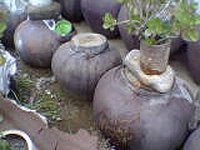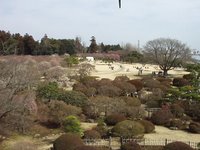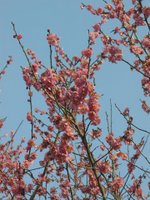:::::::::::::::::::::::::::::::::::::::::::::::::::::::::::::::::::::::::::::::::::::::::::::::::::::
Pounding rice (mochi tsuki, mochitsuki)
***** Location: Japan, Philippines, other areas
***** Season: Mid-winter
***** Category: Humanity
*****************************
Explanation
pounding rice, mochi tsuki (mochitsuki) 餅つき
song for pounding rice, mochi tsuki uta 餅つき歌
having your rice pounded for a fee, chin mochi 賃餅
spreading the pounded rice, noshi mochi 熨斗餅
cutting the spread rice in squares, mochi kiru 餅切る
straw mat to lay the ready dumplings on,
mochi mushiro 餅筵
Pounding rice for small rice dumplings (sometimes translated as "cakes", but they are not sweet at all) is a ubiquious sight all over Japan during the few days before the New Year. It used to be done in a wooden or stone basin with a large wooden mallet, but nowadays many families use an electric appliance, although complaining that the taste is just not the same. The rice dumplings are put in the special soup on the first of January (zooni, see below) and the round rice dumplings are seasonal offerings for the Gods (kagami mochi, see below).
Pounding rice and preparing soup or dumplings and cakes is quite fun and the big local event at our grammar school is a get-together of the whole mountain village community.

People in Edo who could not pound their own mochi used professionals to make
hikizuri mochi 引き摺り餅 with common tools and rice provisions.

source : edococo.exblog.jp
. Doing Business in Edo - 江戸の商売 .
The round mochi were the fore-runners of the money gifts, o-toshidama
. o toshidama お年玉 New Year Treasures.
More kigo are given below.
Gabi Greve
:::::::::::::::::::::::::::::::::::::::::::::::::::::::::::::::::::::::::::::::::::::::::::::::::::::::
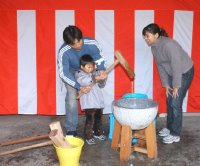
Mochi is finely ground cooked rice pressed into shapes. This creates soft, chewy shapes which can be used in sweet and savory foods. If kept, they form hard blocks, which can be stored until they are needed. Mochi is also combined with roasted soy bean flour (kinako) or sweet bean paste (anko) to make traditional Japanese sweets.
Traditionally, making mochi is a group activity. Village people sat together, hand-pounding the rice with a wooden mallet (kine). According to Shinto tradition, each grain of rice represents a human soul, so the process was reflective and self-purifying for the whole community.
In the West, when we look at the moon, we see a man on it. The Chinese see a rabbit, pounding magical herbs to make the elixir of eternal life. The Japanese, with their love of obscure wordplays, envision the same rabbit pounding rice to make mochi. The name of the full moon is “mochizuki”, while “mochitsuki” means “making mochi”.
The rice dumplings are extremely sticky and difficult to swallow, and many people choke to death on them every year. The New Year is a particularly dangerous season, because many people eat o-zooni, a traditional soup containing mochi, which is served on New Year’s Day. Newscasts feature an annual “death toll” of all the old or drunk people who bit off more mochi than they could chew. In one case, a 70-year-old man was saved from a glutinous death by his resourceful daughter, who used a vacuum cleaner to remove the hazardous blob he was choking on.
http://ballz.ababa.net/uninvited/mochi.htm
xxxxxxxxxxxxxxxxxxxxxxxxxxxxx
The Hare (Rabbit) in the Moon
The Universe and Human Life
By Daisaku Ikeda
In recent years, ever since man began launching satellites into space, his ideas about the universe have been undergoing a profound though little noticed change.
The science of astronomy has existed since ancient times, yet when we as children in Japan looked at the full moon, we invariably saw in it the image of a rabbit pounding glutinous rice to make rice cakes because that was what the adults had told us existed in the moon. The adults, we learned later, had told us a lie. But even the adults, when they looked at the full moon, particularly in the Autumn, probably had thoughts almost as stereotyped as ours, thoughts like those expressed as early as the Heian period by the ninth century poet. Oe no Chisato in his famous verse on the full moon:
When I gaze at the moon
All things seem sad
Though I know the Autumn
Comes not to me alone.
Read the rest here:
http://www.buddhistinformation.com/universe_and_human_life.htm
Safety Copy is here:
http://groups.yahoo.com/group/Haiku-Essays/message/94

source : us6.campaign-archive1.com
Tomita Keisen (1879-1936)
The poem on the hangning scroll reads:
Clearly I can see -
The sacred rabbit
is pounding tea leaves.
*****************************
Worldwide use
*****************************
Things found on the way
Japanese Link with detailed story about the Chinese and Japanese version of the Hare in the Moon.

http://www.asahi-net.or.jp/~nr8c-ab/afjptukiusagi.htm
xxxxxxxxxxxxxxxxxxxxxxxxxxxxx
A local wooden toy from Kanazawa 金沢 餅つき兎

CLICK for more photos !
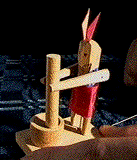
http://www.asahi-net.or.jp/~QB1T-FJT/mochiu.html
. Ishikawa Folk Art - 石川県 .
xxxxxxxxxxxxxxxxxxxxxxxxxxxxxxxxxxxxxxxxxxxxxxxxxxxxxxxxxx
The Real Rabbit in the Moon
"The bunny's two ears point up from New Zealand but point down when seen from England, so many northern people do not recognise our familiar moon rabbit.
However, Maya Indians are supposed to have recognised the moon rabbit.
The Rabbit is made of black moon lava."
© Photo by by John Wattie, NZ
More of his photos are on this LINK
http://nzphoto.tripod.com/astro/#rabbit
There is another moon photo about this on a Japanese page, where you can see the rabbit pounding rice:
http://www2j.biglobe.ne.jp/~hoshino/tsuki%20to%20usagi.htm
:::::::::::::::::::::::::::::::::::::::::::::::::::::::::::::::::::::::::::::::::::::::::::::::::::::
heaven kigo for all autumn
gyokuto 玉兎(ぎょくと)
"treasure hare", treasure rabbit
tsuki no usagi 月の兎(つきのうさぎ)
hare in the moon, rabbit in the moon
. Tamausagi - The Treasure Hare from Gassan, Yamagata
. Lady Chang-O, The Moon Lady .
Jooga 嫦娥 Joga, Chang'e // Kooga 姮娥 Koga, Heng'e
She has the 玉兔 tama usagi pound medicine for her in the moon.
:::::::::::::::::::::::::::::::::::::::::::::::::::::::::::::::::::::::::::::::::::::::::::::::::::::
Mani Moon Hand, gessei manishu
月精摩尼手 (げっせいまにしゅ)

Gakko Bosatsu 月光菩薩 (Moonlight Bosatsu)
Gachirin (moon disc) with a rabbit pounding mochi (glutinous rice) drawn inside. In Japan, Gakkō is also associated with a hare. People suffering high temperatures or fevers can purchase such talismans or icons (called Gessei manishu 月精摩尼手), which are said to reduce fever and cool the body.
Nikko (Sunlight Bosatsu) & Gakko (Moonlight Bosatsu)
Mark Schumacher
In India's ancient language Sanskrit,
one of the names for the moon is 'sashi', and rabbit is also called as 'sashi' in Sanskrit.
:::::::::::::::::::::::::::::::::::::::::::::::::::::::::::::::::::::::::::::::::::::::::::::::::::
Some more worldwide Rabbit Lore
WKD Library
*****************************
HAIKU
pounding rice cakes---
a lull between
typhoons
robert wilson (Philippines)
xxxxxxxxxxxxxxxxxxxxxxxxxxxxx
pounding rice cakes -
midnight temple bells,
New Year guests
Joachim
http://groups.yahoo.com/group/WHCworldkigo/message/991
xxxxxxxxxxxxxxxxxxxxxxxxxxxxxxxxxxx
cha no mochi
green rice cakes:
family chants to the beats
of a mallet
Chibi Dennis Holmes
xxxxxxxxxxxxxxxxxxxxxxxxxxxxxxxxxxxxxxxx
pounding mochi
for cakes
instead of wine
shanna
:::::::::::::::::::::::::::::::::::::::::::::::::::::::::::::::::::::::::::::::::::::::::::::::::::::
Issa and Pounding Rice
From a discussion in Translating Haiku Forum, August 2006
犬の餅烏が餅もつかれけり
inu no mochi karasu ga mochi mo tsukare keri
one for the dog
one for the crow...
rice cakes
Tr. Lanoue
by Issa, 1819
From my experience in rural Japan, where the pounding of rice is made outside in the farm yard, I can imagine more than one dog and one crow waiting for the cakes to be ready ...
> > > > pounding rice ...
> > > > rice dumplings for the dogs
> > > > rice dumplings for the crows
Tr. Gabi Greve
Sakuo was wondering if the poor farmers of the Edo period really had enough to pound rice and give some leftovers to the dogs and birds. Farmers mostly ate buckwheat and such grains.
To this worry, Larry Bole had the following answer
I think Issa's emotions in writing this haiku are amusement and empathy. I think he has a humorous appreciation of the expertise in thievery displayed by these opportunistic scavengers. We know in advance that at least a couple of the rice cakes we are laboriously making are going to end up with the dog and crow, but even knowing that, we aren't going to begrudge them their share.
And I think there is an underlying empathy in that, by stealing rice cakes, the dog and crow are celebrating the New Year along with us in their own way.
There is another rice cake haiku by Issa which R. H. Blyth interprets in much the same vein:
mochitsuki ga tonari e kita to iu ko nari
"The rice-cake makers
Have come next door,"
Says the child.
Blyth says about this haiku:
"'Mochi' is made from a special kind of rice, boiled and pounded into a [glutinous] mass. Japanese people all enjoy it very much; it corresponds (in feeling, not in taste) to Christmas pudding in Europe and America. Pounding the rice is hard work and needs a very large mallet etc., and specialists, so to speak, go from house to house making it.
Some are too poor to afford it, and of such is the child who is speaking. He runs in to his mother and tells her that the men who make the mochi have come to the house next door. The mother cannot answer; there is nothing to say. They cannot afford it, and other children must have the happiness forbidden to hers. ..."
David Lanoue, on the other hand, translates it and then says:
"The rice cake man
is next door!"
the child announces.
"The reader need not see it this [Blyth's] way. The child bubbles over with excitement and anticipation--feelings that Issa and his adult readers share, as they remember their own childhoods."
Lanoue's reading is more in the spirit of another of Issa's haiku:
ako ga mochi ako ga mochi tote narabe keri
"This is sonny-boy's rice-cake,
This is sonny-boy's rice-cake too."
Piling them up.
tr. Blyth
my child's rice cakes
my child's rice cakes...
all in a row
tr. Lanoue
It's interesting to me that Blyth's interpretation comes at a time when both England and Japan were suffering post-war food shortages, whereas Lanoue's interpretation comes from someone living in a land of (relative) plenty, in one of its most plentiful times.
From reading through the 'rice cake' haiku on Lanoue's translastion site, it seems that besides the New Year, rice cakes are also associated with the Girl's Doll Festival, and with a 12th day of the ninth month celebration honoring Nichiren.
Issa also has several haiku about rice cakes being stolen by dogs in one way or another.
And what are we to make of left-over rice cakes?
There is Matsuo Basho's justly-famous haiku:
鴬や餅に糞する縁の先
uguisu ya mochi ni fun suru en no saki
uguisu ya mochi ni funsuru en no saki
Ah! the uguisu
Pooped on the rice-cakes
On the verandah.
tr. Blyth
A warbler
excreting on a rice cake
on the veranda.
Through an unconventional haikai image, the bird’s excreting, Bashô’s verse breaks drastically with the convention and discovers poetry in the natural and the low. Concerning this poem, Bashô wrote to one of his disciples, Sanpû:
“This poem shows what I have been working on lately.”
source : Basho-and-the-Dao - Peipei-Qiu
a bush warbler
dropped poop on the cookies
at the edge of the verandah
tr. Jane Reichhold
bush warbler--
a dropping on the rice cake
at the veranda's edge
tr. Ueda
Basho is quoted as saying about this haiku [in a letter to Sampu]:
"This hokku shows the kind of innovation [karumi] I am trying to achieve nowadays."
Yamamoto says:
"This hokku presents a scene of moldy rice cakes placed in the sunlight on the veranda several weeks after the New Year. Suddenly a bush warbler flew in from the garden and let a dropping fall. This is an idyllic scene filled with spring sunshine."
Would old, uneaten holiday rice cakes be put out for the birds and other animals to eat?
This hokku has the cut marker YA at the end of line 1.
All haiku about mochi by
. Matsuo Basho 松尾芭蕉 - Archives of the WKD .
Mochi no Hosomichi もちの細道 in Memory of Matsuo Basho
:::::::::::::::::::::::::::::::::::::::::::::::::::::::::::::::::::::::::::::::::::::::::::::::::::::
Another Issa Haiku under discussion
草の庵年取餅を買にけり
kusa no io toshitori mochi o kai ni keri
thatched hut--
the year's last rice cakes
are bought
Translated by David Lanoue
More ISSA Haiku about Pounding Rice
The discussion started with another translation of this haiku
thatched hut--
the aged rice cake
is purchased
Translating Haiku Forum Nr. 853 / 855 / 858 / 864
In former times, it was customary in Japan to add one year to one's life on the first of January (toshitori). Individual birthdays were not celebrated.
to get older, toshi o toru 年を取る
thatched hut -
buying rice dumplings
to grow older another year
(Tr. Gabi Greve)
"yellowtail tuna to pass into the New Year" toshitori buri 年取鰤 is a speciality for New Year in Western Japan.
The use of IO, iori, 庵 the thatched hut
Translating Haiku Forum
餅搗のもちがとぶ也犬の口
mochi tsuki no mochi ga tobu nari inu no kuchi
the fresh rice cake
goes flying ...
the dog's mouth
.......................................................................
町並やこんな菴でも餅さはぎ
machinami ya konna io de mo mochi-sawagi
rows of houses --
this house, too, excited
making rice cakes
This hokku is from the eleventh month (December) of 1816, when Issa was away from his hometown on a year-end visit to the greater Edo area, a trip during which he stayed with various haikai poets. The image of rows of houses suggests he was in downtown Edo when he wrote this hokku. The first line also seems to indicate that he's acting just like all the city people in Edo even though he's a visitor now. Issa uses a humble word for "this house," so I take him to mean "the house were I an humbly staying like this." The excitement and energy of getting ready for the new year is intense, so presumably Issa joins in the preparations. On this day the household is making rice cakes of various sizes, including some large ones to be displayed in front of the small house altar to ancestors on New Year's Day before being eaten later. In the small urban backyard some people pound the rice into a soft glutinous mass with a large, heavy wooden mallet while others in the kitchen knead, shape, and smooth the mass into round cakes. People are in an upbeat mood, and sometimes they no doubt shout out encouragement or sing work songs, including songs that invoke the gods and mythical themes as they pound the sticky mass of mashed rice with the big mallet and shape it into cakes.
I don't have a photographic copy of Issa's diary, so I follow the text in Maruyama Kazuhiko, Issa Shichiban-nikki 2.279, which has konna in the second line instead of the donna given in Issa's Complete Works. This reading seems to make more sense, since Issa uses "this humble hut" for the house where he is staying in Edo. This term is reflexive and refers to the speaker in a humble way that is also polite to other people and houses. It is unlikely that Issa would refer to all the houses in Edo as humble huts unless he were literally referring to a very rundown part of the city. Maruyama's text also shows that Issa uses the character 菴 for 'hut,' a character that was commonly used in Issa's time. For those who know Japanese, you can see it has the grass radical at the top, suggesting a classical grass hut. Issa's Complete Works often uses characters that are common in contemporary Japanese instead. In this case, the Complete Works uses the character 庵 for hut, a character that has the house radical at the top.
Chris Drake
. Kobayashi Issa 小林一茶 in Edo .
:::::::::::::::::::::::::::::::::::::::::::::::::::::::::::::::::::::::::::::::::::::::::::::::::::::
to my hut too
New Year's arrives...
the zooni vendor
waga io ya ganjitsu mo kuru zooni uri
我庵や元日も来る雑煮売
by Issa, 1817
Zooni, glutinous rice cakes with vegetables, is enjoyed in the New Year's season.
This haiku has the prescript, "In Hatsuchoobori Beggar Quarter, I greet the spring."
Hattchoobori was a district of old Edo (today's Tokyo). See Maruyama Kazuhiko, Issa haiku shuu (Tokyo: Iwanami Shoten, 1990; rpt. 1993) 261, note 1394.
Shinji Ogawa offers this translation:
To my hut
even on the New Year's Day
zooni vendors come
He notes that it is a Japanese custom not to work during the first three days of the year, but in the big city of Edo, zooni vendors were busy as bees.
Tr. David Lanoue
http://cat.xula.edu/issa/
. Kobayashi Issa 小林一茶 in Edo .
*****************************
Related words
***** New Year's Rice Dumplings
(toshi no mochi 年の餅)
kigo for the New Year
"mirror rice dumplings, kagami mochi 鏡餅
..... a special offering for the gods at New Year. They get very hard, are then split with a hammer and put into soup.
"honorable mirror" rice dumplings, o-kagami 御鏡
"armor plate" rice dumplings, yoroi mochi 鎧餅
"rice sumplings for the ancestors" offered for the ancestors at home
..... gusoku mochi 具足餅
rice dumplings for the new year soup (zooni),
zooni mochi 雑煮餅
Mixed vegetable soup for the new year (zooni, a kigo for the New Year) is eaten on January first in the morning, usually after the first shrine visit and prepared with .. the first well water (wakamizu) .
In Western Japan, it is the custom to add a lot of yellowtail (buri) to the broth of vegetables.
People greet each other on the first of January: What did you eat in your zooni?
After that, no hot food was eaten until January 4, to give the housewive and the kitchen and hearth deities a short holiday.
Click HERE to look at some photos !
New Year's rice dumplings, toshi no mochi, 年の餅
..... made as a gift for neighbours and visitors (we often get our share of these hard presents)
Quote:
..... even the poor cooked pure boiled rice and pounded rice cake from pure glutinous rice for important meals. Pounded rice cakes (mochi), prepared by pounding steamed glutinous rice with a mortar and pestle, have been indispensable food items for Japanese ceremonial feasts. People thought that the essence — the sacred power of rice — was made purer by pounding, and mochi was believed to contain the "spirit of rice."
Naturally this was and is the most celebrated form of rice and therefore the most appropriate food for feasts. Thus, New Year’s day, the principal annual feast in Japan, sees mochi always consumed as a ceremonial food.
Read more:
Food of Japan, by Naomichi Ishige !!!!!
:::::::::::::::::::::::::::::::::::::::::::::::::::::::::::::::::::::::::::::::::::::::::::::::::::::
animal kigo for all winter
usagi 兎 (うさぎ) hare, rabbit
yukiusagi, yuki usagi 雪兎 ゆきうさぎ snow hare
nousagi, no usagi 野兎(のうさぎ)hare
Echigo usagi 、越後兎(えちごうさぎ) hare from Echigo
usagigari 兎狩 (うさぎがり) rabbit-hunting
usagi ami 兎網(うさぎあみ) net for hunting rabbits
usagi wana 兎罠(うさぎわな)trap for hunting rabbits
Rabbits and hares are counted as "ichiwa 一羽, niwa 二羽", like birds with wings, when mentioned in a culinary and literary context. They are eaten by Buddhists, even if they have four legs.
Biologically, they are counted as "ippiki 一匹, nihiki 二匹" one animal, two animals.
:::::::::::::::::::::::::::::::::::::::::::::::::::::::::::::::::::::::::::::::::::::::::::::::::::::

kigo for the New Year
Hatsu U (hatsu-u) 初卯 (はつう)
first day of the rabbit/hare
hatsu-u maitsuri 初卯祭(はつうまつり)first day of the rabbit festival
hatsu u mairi 、初卯詣(はつうまいり)visiting a shrine for the rabbit festival
In Edo to the shrine Kameido Tenmangu, in Kyoto to the shrine Iwashimizu Hachimangu, in Osaka to the shrine Sumiyosh Taisha. Also other Tenmangu-Shrines in Japan.
In the year of the rabbit, this visit was especially popular in the Edo period.
u no fuda 卯の札(うのふだ)"rabbit votive tablet" (for this day)
ni no u 二の卯(にのう)second day of the rabbit
san no u 三の卯(さんのう)third day of the rabbit
Kameido Myoogi mairi 亀戸妙義参(かめいどみょうぎまいり)
the special talisman is used as a hair decoration, at Kameido Tenmangu Shrine, Edo.
Festival at all Tenmangu shrines in memory of Sugawara Michizane, who is said to have died on the day of the rabbit, hour of the rabbit.
People buy special talismans to ward off evil for the coming year. Especially for the Emperor and his ladies in waiting, later it became a common festival for all.
. Sugawara Michizane 菅原道真

u no o-fuda 卯の神札(うのおふだ) votive tablet

uzuchi 卯槌(うづち)uzuchi talisman
It was given as a token to the Imperial palace since the Heian period.
It is made from peach wood and strings in five auspicious colors.
It wards off evil influence.
observance kigo for the New Year
uzue 卯杖 (うづえ) stick talsiman
..... u no tsue 卯の杖(うのつえ)
hatsu uzue 、hatsu uzue 初卯杖(はつうづえ)、 first uzue stick
iwai no tsue 祝の杖(いわいのつえ)auspicious uzue stick
uzue no hogai 卯杖の祝(うづえのほがい)
uzue no kotobuki 卯杖の寿(うづえのことぶき)
It was made from holly wood, peach, plum, willow and others, about 1.6 meters long.
Strings in the five auspicious colors were added.
. . . CLICK here for UZUE Photos !
SAIJIKI – NEW YEAR OBSERVANCES
. Amulets from Edo / Tokyo .
:::::::::::::::::::::::::::::::::::::::::::::::::::::::::::::::::::::::::::::::::::::::::::::::::::::
Otherwise the hare and rabbit are not kigo.
Rabbit and hare ...
Kigo Hotline, November 2008
:::::::::::::::::::::::::::::::::::::::::::::::::::::::::::::::::::::::::::::::::::::::::::::::::::::
*********** NEW YEAR FOOD SAIJIKI
. WKD : New Year Ceremonies
. ANIMALS in all SEASONS - SAIJIKI
:::::::::::::::::::::::::::::::::::::::::::::::::::::::::::::::::::::::::::::::::::::::::::::::::::::::::::::::::::::::::::
[ . BACK to DARUMA MUSEUM TOP . ]
[ . BACK to WORLDKIGO . TOP . ]
-- #mochitsuki #poundingrice
:::::::::::::::::::::::::::::::::::::::::::::::::::::::::::::::::::::::::::::::::::::::::::::::::::::::::::::::::::::::::::



